The ILA 2016 Conference & Exhibits in Boston featured many authors of children’s and young adult books. Attendees who registered an Author Meetup session had the opportunity to spend 10 minutes with each of seven authors in a chosen level (primary, mid-level, or young adult). Each of these authors has recently published books that will engage, intrigue, and inspire readers.
Ages 4–8
Listen to Our World. Bill Martin Jr. & Michael Sampson. Ill. Melissa Sweet. 2016. Paula Wiseman/Simon & Schuster.
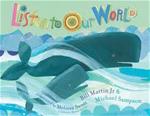 Opening with good-morning kisses and a “Can you hear the sounds of our world?” and ending with good-night kisses and wishes for sweet dreams, this picture book extends an invitation to young children to “Listen! Listen! Listen!” to the world. Martin and Sampson’s spare, lyrical text and Sweet’s warm, colorful illustrations—rendered in watercolors, handmade papers, and mixed media—introduce 11 parent–offspring pairings of animals in their natural environments. The repetition of the sounds made by each animal is incorporated into double-page spreads, oriented horizontally or vertically to best present the animals in their habitats. For example, an adult crocodile and two young ones spread across a horizontal double page, showcasing their elongated bodies as they glide through algae in their marshland world. “SNAP! SNAP! SNAP!” End notes present brief facts, including habitat and range, for each of the animals in the book.
Opening with good-morning kisses and a “Can you hear the sounds of our world?” and ending with good-night kisses and wishes for sweet dreams, this picture book extends an invitation to young children to “Listen! Listen! Listen!” to the world. Martin and Sampson’s spare, lyrical text and Sweet’s warm, colorful illustrations—rendered in watercolors, handmade papers, and mixed media—introduce 11 parent–offspring pairings of animals in their natural environments. The repetition of the sounds made by each animal is incorporated into double-page spreads, oriented horizontally or vertically to best present the animals in their habitats. For example, an adult crocodile and two young ones spread across a horizontal double page, showcasing their elongated bodies as they glide through algae in their marshland world. “SNAP! SNAP! SNAP!” End notes present brief facts, including habitat and range, for each of the animals in the book.
—CA
Our Food: A Healthy Serving of Science and Poems. Grace Lin & Ranida T. McKneally. Ill. Grace Zong. 2016. Charlesbridge.
 Following a “Why We Eat” introduction, this nonfiction book, illustrated with colorful acrylic paintings featuring five inquisitive children visiting a farm to learn about the foods we eat, devotes three double-spread pages to each of the five food groups: fruit, vegetables, grains, protein, and dairy products. Each double page opens with a question, followed by a poem in free verse and, in a column of text, an answer to the question. Lin and McKneally answer questions such as “What makes grain a grain?” and “What are protein foods?” but also more intriguing questions such as “Why do beans make you gassy?” and “What makes popcorn pop?” They provide numerous examples as they explain the nutritional value of particular foods and encourage young readers to make sure they eat nutritious food to power their bodies. The back matter includes a glossary.
Following a “Why We Eat” introduction, this nonfiction book, illustrated with colorful acrylic paintings featuring five inquisitive children visiting a farm to learn about the foods we eat, devotes three double-spread pages to each of the five food groups: fruit, vegetables, grains, protein, and dairy products. Each double page opens with a question, followed by a poem in free verse and, in a column of text, an answer to the question. Lin and McKneally answer questions such as “What makes grain a grain?” and “What are protein foods?” but also more intriguing questions such as “Why do beans make you gassy?” and “What makes popcorn pop?” They provide numerous examples as they explain the nutritional value of particular foods and encourage young readers to make sure they eat nutritious food to power their bodies. The back matter includes a glossary.
—SW
Playing From the Heart. Peter H. Reynolds. 2016. Candlewick.
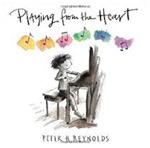 As a young boy, Raj discovers the piano in the house where he lives with his father. Fearlessly, he explores making music and, as he grows taller, discovers the effects of using the pedals. When his father finds him a piano teacher, Raj works hard as a student but over the years, tired of the practice, he closes the piano. Marking the passage of time, the illustrations, warm and earth-toned at the beginning when Raj is a young child, become blue and gray when he ceases to make music. Years later, when Raj learns his father is ill, he returns home and, in playing the nameless song that his father loves and requests, Raj finds renewed joy in playing the piano for himself and his father. The illustrations—rendered in pen, ink, watercolor, gouache, and tea—are playful and delicate, reflecting the heartfulness of the story.
As a young boy, Raj discovers the piano in the house where he lives with his father. Fearlessly, he explores making music and, as he grows taller, discovers the effects of using the pedals. When his father finds him a piano teacher, Raj works hard as a student but over the years, tired of the practice, he closes the piano. Marking the passage of time, the illustrations, warm and earth-toned at the beginning when Raj is a young child, become blue and gray when he ceases to make music. Years later, when Raj learns his father is ill, he returns home and, in playing the nameless song that his father loves and requests, Raj finds renewed joy in playing the piano for himself and his father. The illustrations—rendered in pen, ink, watercolor, gouache, and tea—are playful and delicate, reflecting the heartfulness of the story.
—SW
Ages 9–11
Child of Spring. Farhana Zia. 2016. Peachtree.
 Basanta is a servant for the demanding Bibi, the young girl in the Big House, and has to learn many rules for serving in the house. Basanta’s mother encourages her to be kind, generous, and honorable in spite of the criticism of Memsaab, the lady of the house, and the pranks of other children in the busti, the community of huts where Basanta lives. Accused of stealing a precious ring, Basanta redoubles her efforts of doing good work that will bring her and her family credit in the Big House. She creates a problem for herself when she finds the beautiful ring, lost under a bookcase, and, instead of telling her Amma about the find, she hides it in the box holding her family’s treasures, arguing to herself that it will be replaced and not missed. In the context of daily activities in her community, her chores in the Big House with Bibi, the rescue of a little dog, and Divali festivities, Basanta has to reckon with her worried heart and consequences of her actions.
Basanta is a servant for the demanding Bibi, the young girl in the Big House, and has to learn many rules for serving in the house. Basanta’s mother encourages her to be kind, generous, and honorable in spite of the criticism of Memsaab, the lady of the house, and the pranks of other children in the busti, the community of huts where Basanta lives. Accused of stealing a precious ring, Basanta redoubles her efforts of doing good work that will bring her and her family credit in the Big House. She creates a problem for herself when she finds the beautiful ring, lost under a bookcase, and, instead of telling her Amma about the find, she hides it in the box holding her family’s treasures, arguing to herself that it will be replaced and not missed. In the context of daily activities in her community, her chores in the Big House with Bibi, the rescue of a little dog, and Divali festivities, Basanta has to reckon with her worried heart and consequences of her actions.
—SW
Forest of Wonders (Wing & Claw #1). Linda Sue Park. Ill. James Madsen. 2016. Harper/HarperCollins.
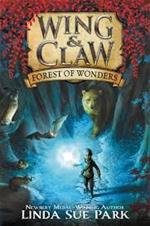 When 12-year-old Raffa Santana, a talented young apothecary, uses a rare crimson vine he and his cousin Garith discover in the Forest of Wonders to heal a bat that has been severely injured by an owl, something strange and unexpected happens. The bat, that Raffa names Echo, can now talk. Fearing that Garith might use a cutting from the vine carelessly, Raffa sets off to Gilden, where his uncle is the government’s official apothecary for a secret project. Uncle Ansel wants Raffa to use the vine to increase the potency of infusions being used to make it easier to train animals from the Forest of Wonders to do routine tasks normally done by people. Raffa’s discovery of the cruelty of the experiments and the evil intent of the government sets up the exciting ending of this first book in Park’s new fantasy trilogy and will leave readers eagerly waiting to following Raffa and Echo’s adventures as they continue in the second book.
When 12-year-old Raffa Santana, a talented young apothecary, uses a rare crimson vine he and his cousin Garith discover in the Forest of Wonders to heal a bat that has been severely injured by an owl, something strange and unexpected happens. The bat, that Raffa names Echo, can now talk. Fearing that Garith might use a cutting from the vine carelessly, Raffa sets off to Gilden, where his uncle is the government’s official apothecary for a secret project. Uncle Ansel wants Raffa to use the vine to increase the potency of infusions being used to make it easier to train animals from the Forest of Wonders to do routine tasks normally done by people. Raffa’s discovery of the cruelty of the experiments and the evil intent of the government sets up the exciting ending of this first book in Park’s new fantasy trilogy and will leave readers eagerly waiting to following Raffa and Echo’s adventures as they continue in the second book.
—CA
Time Stoppers. Carrie Jones. 2016. Bloomsbury.
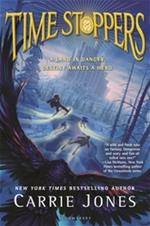 Annie Nobody (who has just been placed in her 12th worst-ever foster home) and Jamie Alexander (who lives with his father and grandmother under the threat of being eaten by them if he doesn’t turn into a troll like them as he turns 13) are rescued from their unhappy situations by Eva Beryl-Axe, a scrappy dwarf who whisks them away to Aurora on a flying snowmobile. Aurora is a hidden safe-haven for magical beings of all sorts, including dwarfs, giants, witches, vampires, and hags. Annie, who has always been told she is nothing special, is surprised to have the citizens of Aurora welcome her as a magical human with the power to stop time and whose destiny is to save Aurora. With the help of Jamie, Eva, and an elf named Bloom, Annie sets out on a dangerous mission to recover the stolen magical gnome that protects Aurora from detection. But with the gnome back within the town’s borders, does Annie finally have a safe, happy-ever-after home? The ending of this first book in the Time Stoppers series forecasts more adventure and danger for Annie and her friends.
Annie Nobody (who has just been placed in her 12th worst-ever foster home) and Jamie Alexander (who lives with his father and grandmother under the threat of being eaten by them if he doesn’t turn into a troll like them as he turns 13) are rescued from their unhappy situations by Eva Beryl-Axe, a scrappy dwarf who whisks them away to Aurora on a flying snowmobile. Aurora is a hidden safe-haven for magical beings of all sorts, including dwarfs, giants, witches, vampires, and hags. Annie, who has always been told she is nothing special, is surprised to have the citizens of Aurora welcome her as a magical human with the power to stop time and whose destiny is to save Aurora. With the help of Jamie, Eva, and an elf named Bloom, Annie sets out on a dangerous mission to recover the stolen magical gnome that protects Aurora from detection. But with the gnome back within the town’s borders, does Annie finally have a safe, happy-ever-after home? The ending of this first book in the Time Stoppers series forecasts more adventure and danger for Annie and her friends.
—CA
Ages 12–14
The Girl I Used to Be. April Henry. 2016. Henry Holt.
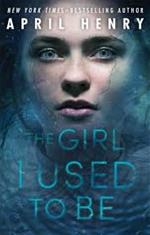 Olivia, an emancipated 17-year-old living alone in Portland, has always believed that, when she was only 3, her father killed her mother in a Southern Oregon woods where they had gone to get a Christmas tree, abandoned her at Walmart, and fled. Now remains of her father’s body have been found in the same woods. Olivia moves to Medford, never letting anyone know that she is Ariel Benson, the young girl who survived. Although Police Chief Spaulding, who has reopened the case, seems to accept that a serial killer was responsible, Olivia, through a variety of research avenues, comes to believe that several of her parents’ friends are likely suspects. The first chapter, in which a girl is chased through the same woods by a killer, foreshadows the danger into which Olivia’s investigation places her in this fast-paced, well-plotted thriller.
Olivia, an emancipated 17-year-old living alone in Portland, has always believed that, when she was only 3, her father killed her mother in a Southern Oregon woods where they had gone to get a Christmas tree, abandoned her at Walmart, and fled. Now remains of her father’s body have been found in the same woods. Olivia moves to Medford, never letting anyone know that she is Ariel Benson, the young girl who survived. Although Police Chief Spaulding, who has reopened the case, seems to accept that a serial killer was responsible, Olivia, through a variety of research avenues, comes to believe that several of her parents’ friends are likely suspects. The first chapter, in which a girl is chased through the same woods by a killer, foreshadows the danger into which Olivia’s investigation places her in this fast-paced, well-plotted thriller.
—CA
The Last Boy and Girl in the World. Siobhan Vivian. 2016. Simon & Schuster.
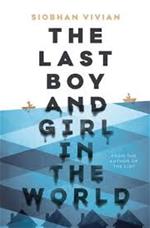 The river coursing through the centuries-old town of Aberdeen floods from ongoing torrential rains; yet Keeley and her friends Morgan and Elise eagerly set out for the spring dance at their high school gym. Keeley’s romance with Jesse, whom she has always adored, begins as her father’s campaign to resist the construction of the dam that will obliterate Aberdeen takes shape. To financially support her parents, Keeley takes a job helping Sheriff Hamrick’s son, Levi, close up condemned houses. As Keeley comes to understand the role her relationship with fun-loving Jesse has in her life, her longtime friendship with Morgan unravels through a series of misunderstandings, secrets, and betrayals. Morgan’s moving away from Aberdeen with her mother leaves Keeley wondering what is to become of their friendship. During a celebration of the opening of the dam, Keeley paddles a kayak to the nearly underwater town and discovers Levi, who, in another kayak, has returned to retrieve a note in one of the houses that might answer Keeley’s question. Friendship lost and found, community action, and environmental disaster inspire Keeley to rethink her relationships and what is important in her life.
The river coursing through the centuries-old town of Aberdeen floods from ongoing torrential rains; yet Keeley and her friends Morgan and Elise eagerly set out for the spring dance at their high school gym. Keeley’s romance with Jesse, whom she has always adored, begins as her father’s campaign to resist the construction of the dam that will obliterate Aberdeen takes shape. To financially support her parents, Keeley takes a job helping Sheriff Hamrick’s son, Levi, close up condemned houses. As Keeley comes to understand the role her relationship with fun-loving Jesse has in her life, her longtime friendship with Morgan unravels through a series of misunderstandings, secrets, and betrayals. Morgan’s moving away from Aberdeen with her mother leaves Keeley wondering what is to become of their friendship. During a celebration of the opening of the dam, Keeley paddles a kayak to the nearly underwater town and discovers Levi, who, in another kayak, has returned to retrieve a note in one of the houses that might answer Keeley’s question. Friendship lost and found, community action, and environmental disaster inspire Keeley to rethink her relationships and what is important in her life.
—SW
Ages 15+
Unexpected Everything. Morgan Matson. 2016. Simon & Schuster.
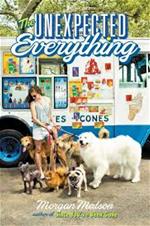 Andie Walker is ready to start a summer internship but loses it when her Congressman father announces he will take a leave of absence from his office during an internal investigation into misuse of funds. Having to adjust to the constant presence of her father, who has been absent from her life since she was three in his role as politician, and needing a summer activity, Andie takes a job as a dog walker. As a dog walker she meets Bertie, a Great Pyrenees, and develops a friendship with Bertie’s guardian, Clark McAllister, a writer who is two years older than she is. Her friends, fascinated by the books McAllister has written, influence Andie as she rethinks what she always believed she wanted. Andie creates new dreams as the relationships with Clark and her father change, and she reconciles her past with her future in ways she does not expect.
Andie Walker is ready to start a summer internship but loses it when her Congressman father announces he will take a leave of absence from his office during an internal investigation into misuse of funds. Having to adjust to the constant presence of her father, who has been absent from her life since she was three in his role as politician, and needing a summer activity, Andie takes a job as a dog walker. As a dog walker she meets Bertie, a Great Pyrenees, and develops a friendship with Bertie’s guardian, Clark McAllister, a writer who is two years older than she is. Her friends, fascinated by the books McAllister has written, influence Andie as she rethinks what she always believed she wanted. Andie creates new dreams as the relationships with Clark and her father change, and she reconciles her past with her future in ways she does not expect.
—SW
Sandip Wilson serves as associate professor in the College of Health and Education of Husson University in Bangor, ME. Carolyn Angus is former director of the George G. Stone Center for Children's Books, Claremont Graduate University, Claremont, CA.
These reviews are submitted by members of the International Literacy Association's Children's Literature and Reading Special Interest Group (CL/R SIG) and are published weekly on Literacy Daily.